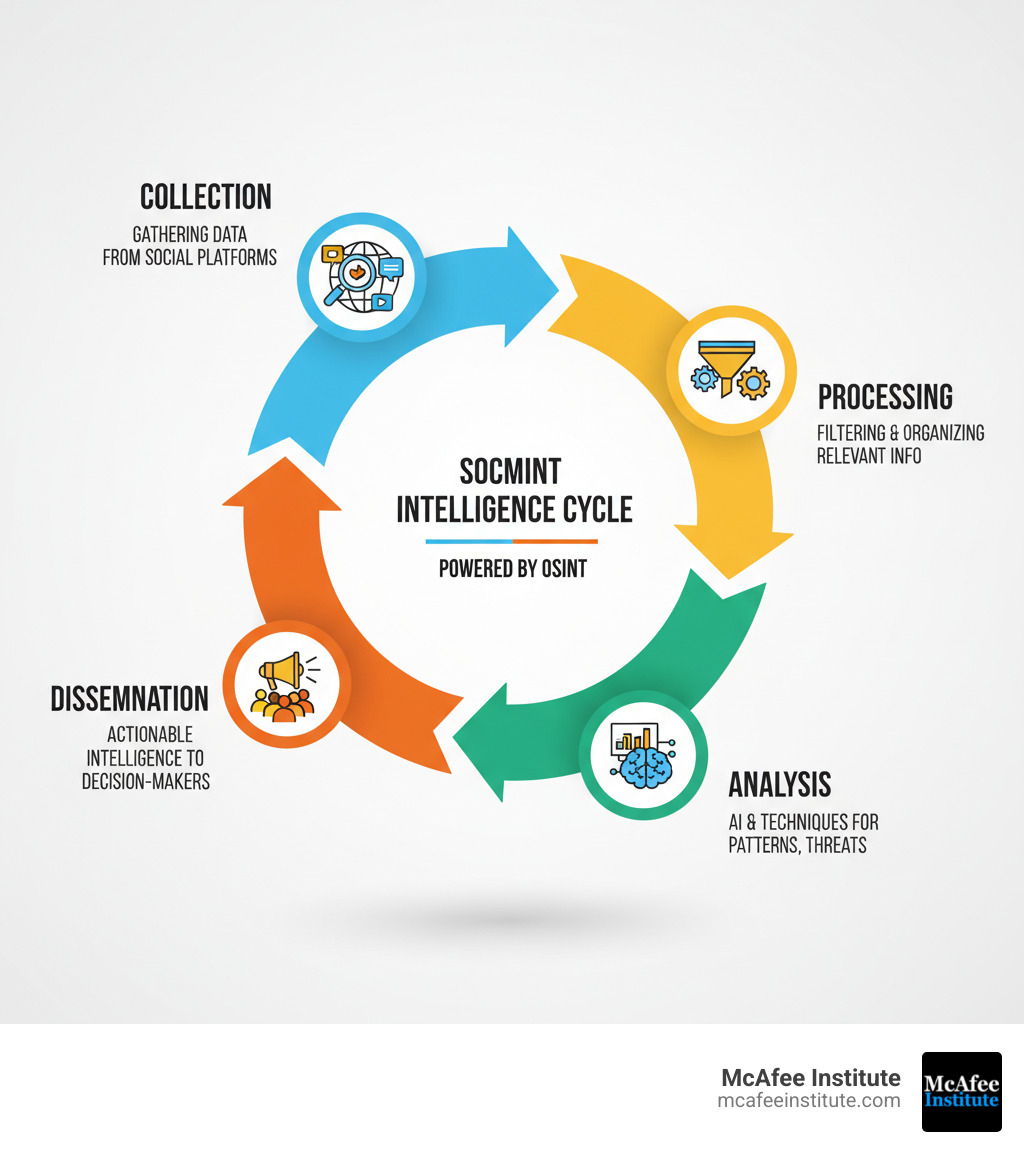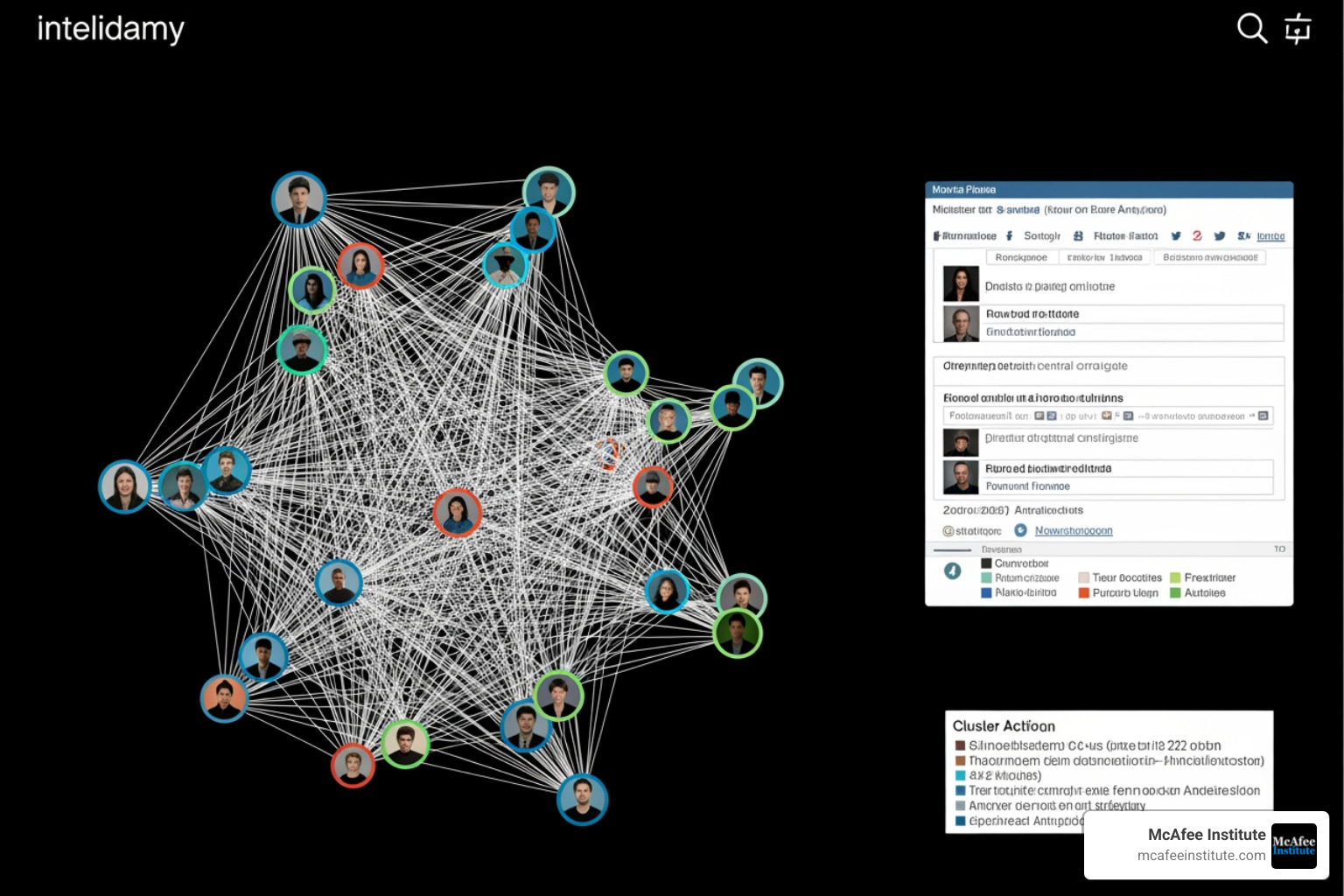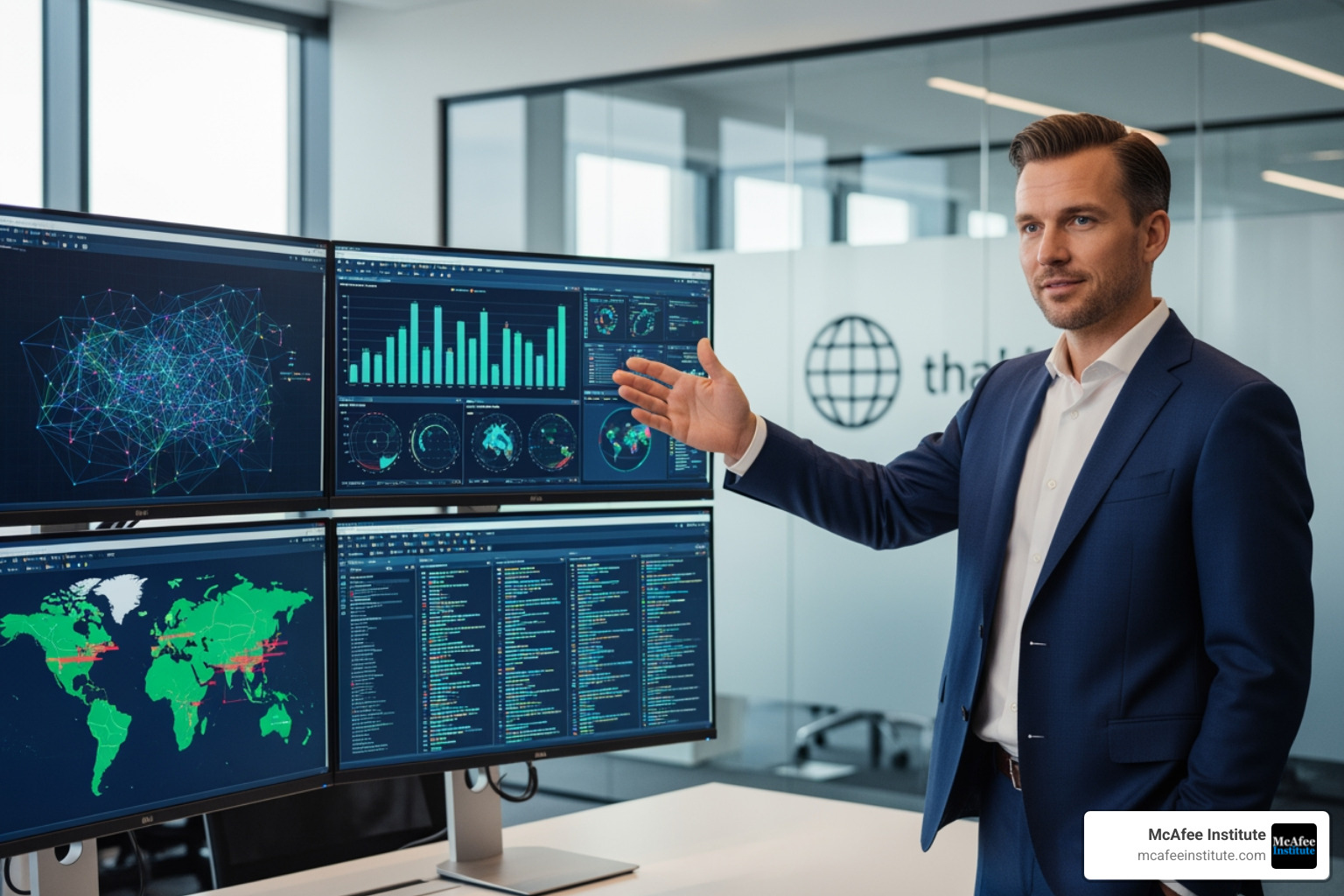Why Social Media Intelligence Matters for Modern Investigations
Social media intelligence (SOCMINT) is the practice of analyzing publicly available data from social media to support investigations and strategic decisions. As a specialized discipline within Open-Source Intelligence (OSINT), it's essential for law enforcement, intelligence agencies, and security professionals.
SOCMINT involves gathering intelligence from platforms like Facebook, X, and TikTok to identify threats and track criminal activity. With over 5 billion users spending hours on these platforms daily, the volume of available intelligence is unprecedented. It's used by law enforcement for investigations and by government agencies for public safety, all while adhering to privacy laws like GDPR and CCPA by focusing exclusively on public data.
The digital landscape has changed investigations. Billions of people share their lives online, creating a massive intelligence opportunity. However, this comes with challenges like data overload, misinformation, and anonymity. For professionals, mastering SOCMINT ethically and effectively is no longer optional.
SOCMINT provides real-time insights that traditional methods can't match, whether for tracking criminal networks or gathering evidence. For instance, the Philadelphia Police Department uses it to prevent robberies. But raw data isn't intelligence; it requires the right tools and framework to turn noise into actionable insights.
I'm Joshua McAfee, and my career, from creating Amazon's Loss Prevention program to training thousands of professionals through McAfee Institute, has focused on turning complex challenges into solutions. I've seen how SOCMINT transforms investigations and have developed government-recognized certification programs to help professionals master this discipline.

SOCMINT vs. Social Listening vs. Monitoring: A Strategic Distinction
The terms "social media monitoring," "social listening," and "social media intelligence" are often used interchangeably, but they represent distinct concepts. For investigators, understanding these differences is critical.
Social media monitoring is the most basic level. It involves tracking mentions, keywords, and hashtags to see what is being said. Think of it as casting a wide net to collect data. It's reactive and focuses on volume and visibility.
Social listening goes a step further by analyzing the context and sentiment behind the data. It helps understand the why behind conversations, such as public feeling about a new policy. It's more analytical but still focused on the present.
Social media intelligence (SOCMINT) operates on a strategic level. It's not just about what's happening now; it's about predicting future behaviors, identifying hidden networks, and assessing threats. As a discipline within Open-Source Intelligence (OSINT), SOCMINT is used by intelligence professionals to prevent crimes and save lives, not just refine marketing campaigns.
SOCMINT analysts map relationships, analyze long-term behavioral patterns, and identify coordinated activity to build comprehensive intelligence pictures for strategic operations.
| Criteria | Social Media Monitoring | Social Listening | Social Media Intelligence (SOCMINT) |
|---|---|---|---|
| Primary Goal | Data collection, tracking mentions, volume metrics | Understanding context, sentiment, and trends | Strategic decision-making, threat assessment, investigations |
| Scope | Surface-level data, brand mentions, keywords | Deeper analysis of conversations, sentiment, themes | Comprehensive analysis of behaviors, patterns, connections |
| Timeframe | Real-time and historical data collection | Real-time and short-term trend analysis | Predictive, long-term strategic insights, historical context |
| Typical User | Marketing teams, customer service | PR, marketing, product development | Intelligence analysts, law enforcement, security professionals |
| Approach | Reactive (What happened?) | Responsive (Why is it happening?) | Proactive (What will happen? How can we act?) |
In short: monitoring tells you a suspect posted. Listening tells you they're angry. SOCMINT reveals their connection to a criminal network, maps their associates, and helps predict their next move. That's the strategic distinction that matters in investigations.
Applications of Social Media Intelligence in Investigations and Public Safety
The "digital dust" trail left by billions of social media users provides an unprecedented opportunity for investigators to solve crimes, prevent threats, and protect communities.
The power of social media intelligence comes from analyzing publicly available information in real-time. This isn't mass surveillance; it's the ethical use of public data for safety, a practice increasingly recognized by government agencies as noted in reports like Social Media Surveillance by the U.S. Government.

Enhancing Criminal Investigations
Social media intelligence has transformed criminal investigations. For example, during the Philadelphia looting incidents in 2023, law enforcement used SOCMINT to track organizers and participants through their public posts.
Key applications include:
- Identifying suspects: Investigators use profile pictures, aliases, and linked accounts to map out networks of associates.
- Tracking criminal activity: Drug dealers, retail crime rings, and gangs often discuss activities in public forums, allowing investigators to identify patterns and intervene.
- Gathering evidence: Posts, images, and metadata like location tags can establish timelines and prove intent in court. Tools like Maltego Evidence help organize this data for analysis, which can be documented using our Investigation Report Guide.
- Event reconstruction: Analyzing posts from an incident helps piece together a timeline of what happened, who was involved, and their motivations.
Proactive Threat Assessment and Public Safety
The most powerful use of SOCMINT is proactive threat assessment.
- Monitoring civil unrest: Identifying trending conversations about protests allows authorities to gauge sentiment and prepare resources to facilitate peaceful assembly.
- Identifying extremist rhetoric: SOCMINT helps track how dangerous narratives spread, identify key influencers, and spot individuals at risk of radicalization, enabling early intervention.
- Preventing organized crime: Mapping connections between online accounts can uncover the hierarchy and structure of criminal organizations, revealing weak points for disruption.
- Public event security: Before and during major events, security teams scan for threats and coordinate rapid responses to emerging issues.
- Crisis management: During disasters, first responders use real-time social media posts from affected residents to allocate resources and coordinate rescue efforts effectively.
For professionals looking to master these skills, the Certified Social Media Intelligence Expert (CSMIE) program offers comprehensive training for ethical and effective SOCMINT operations.
The Investigator's Toolkit: Data, AI, and Best Practices
Effective social media intelligence requires understanding the data, legal and ethical collection methods, and the role of Artificial Intelligence (AI). It's a systematic process of turning raw data into actionable intelligence.

Legally and Ethically Collecting Social Media Data
The cornerstone of credible SOCMINT is a strict focus on publicly available data—information users have explicitly shared, such as public posts, comments, and profile details. Private messages or content requiring unauthorized access are off-limits, as explained by Privacy International.
Adherence to data privacy laws like GDPR, CCPA, and PIPEDA is non-negotiable. This means respecting consent, ensuring transparency, and using compliant tools. Ethical boundaries also guide our work, such as anonymizing data when possible and using it for legitimate purposes.
For investigations, dedicated "sock puppet" accounts can separate professional research from personal activity. However, these must be used ethically and within platform Terms of Service, which often restrict automated data scraping. For more on ethical techniques, see our guide on 5 Incredible OSINT Techniques.
How AI is Changing Social Media Intelligence
AI and machine learning are revolutionizing social media intelligence by enabling analysis at a scale impossible for humans.
- Natural Language Processing (NLP): This AI technique is vital for sentiment analysis, helping to interpret the emotional tone of posts by understanding slang, sarcasm, and nuance at scale.
- Image and Visual Recognition: AI can analyze images and videos to detect objects (like weapons), identify locations, and recognize faces, converting visual data into searchable information.
- Predictive Analytics: By analyzing historical data, machine learning models can forecast trends and potential crises. This, combined with anomaly detection that flags unusual activity, provides early warning signals of emerging threats.
As detailed in How AI is Transforming the Future of Investigations, AI augments, rather than replaces, human analysts by correlating vast datasets in real-time.
Overcoming Key SOCMINT Challenges
Despite its power, SOCMINT has significant challenges:
- Data Volume: The sheer amount of data requires AI-powered tools and clear objectives to avoid being overwhelmed.
- Misinformation and Disinformation: False narratives and troll farms are rampant. Analysts must constantly verify sources, a task where human judgment remains critical.
- Verifying Sources: Anonymity, fake accounts, and bots complicate identity verification. Analysts must look for patterns of inauthentic behavior.
- Echo Chambers: Algorithmic content feeds can skew perceptions of public sentiment, requiring analysts to be aware of potential biases.
Addressing these issues requires a mix of advanced technology and skilled analysts. For more on navigating these complexities, see our guide on Five High-Value OSINT Techniques with AI.
Building a Career in Social Media Intelligence
Demand for skilled social media intelligence professionals is exploding. For those with a curious mind and a desire to make an impact, this field offers dynamic and meaningful career opportunities.

Key roles include:
- Intelligence Analysts in government or private firms who use SOCMINT for national security and risk assessment.
- Law Enforcement Analysts who work with police to identify suspects, track criminal networks, and gather evidence.
- Corporate Security Investigators who protect organizations from threats, fraud, and reputational damage.
- Disaster Response Specialists who use real-time monitoring during crises to coordinate aid and public communication.
Success in SOCMINT requires a blend of skills. Data analysis and critical thinking are fundamental for finding patterns and vetting sources. A strong grasp of legal and ethical frameworks like GDPR and CCPA is essential for maintaining integrity. While tool proficiency with AI platforms is important, adaptability and continuous learning are crucial in a constantly changing digital landscape. Finally, strong communication skills are needed to convey complex findings to decision-makers.
Investing in specialized training is a smart career move. As noted in 10 Reasons Why OSINT Certifications Are Essential for Your Career, government-recognized credentials validate your expertise and open doors. At McAfee Institute, our programs offer lifetime access and updates, because learning in this field never stops. View all Board Certifications to find the right path for your goals. Whether you're transitioning into the field or an experienced professional, the opportunities are growing and rewarding.
Frequently Asked Questions about Social Media Intelligence
Here are answers to common questions about social media intelligence.
What is the difference between SOCMINT and OSINT?
Open-Source Intelligence (OSINT) is the broad practice of collecting intelligence from any public source, including news, government reports, and the internet. Social media intelligence (SOCMINT) is a specialized discipline within OSINT that focuses exclusively on social media platforms. If OSINT is the entire ocean of public information, SOCMINT uses specialized tools to explore its depths.
Is collecting social media intelligence legal?
Yes, collecting social media intelligence is legal when done correctly. The key is that SOCMINT focuses exclusively on publicly available data—information users have voluntarily shared. It is not hacking or accessing private messages. However, practitioners must adhere to privacy laws like GDPR, CCPA, and PIPEDA, which govern data collection and use. Ethical guidelines are equally important, ensuring data is used for legitimate purposes while respecting platform Terms of Service.
What types of data can be analyzed with SOCMINT?
Social media intelligence analyzes a diverse range of data to create a comprehensive picture:
- Structured data: Quantifiable metrics like likes, shares, follower counts, and timestamps.
- Unstructured data: The content itself, including text, comments, images, and videos, analyzed using tools like Natural Language Processing (NLP).
- Geospatial data: Location tags that help map activities and track movements.
- Network data: The connections between users, which reveal relationships and community structures.
- Behavioral data: Patterns of activity, such as posting times and frequency, that can reveal habits.
Combining these data types transforms raw information into actionable intelligence for investigations.
Master the Craft of Digital Investigation
As we've seen, social media intelligence is essential for modern investigations. But the digital world is constantly evolving, making ethical practice and continuous learning paramount for success.
At McAfee Institute, our government-recognized certification programs are designed by practitioners with real-world law enforcement and intelligence experience. We equip you with the expertise to transform raw social media data into actionable intelligence for high-stakes scenarios.
When you enroll, you gain lifetime access to our curriculum, live instructor support, and free updates for life. With no annual renewals or hidden fees, we provide ongoing support for your entire career.
Our certifications are trusted by employers and accredited by U.S. government agencies, giving you a credible edge. The professionals shaping the future of public safety invest in specialized training to master the craft of digital investigation.
Your journey to becoming a Certified Social Media Intelligence Expert (CSMIE) starts now. From our headquarters in Chesterfield, Missouri, we serve professionals globally. The question isn't whether you need these skills—it's whether you're ready to master them.






Member discussion